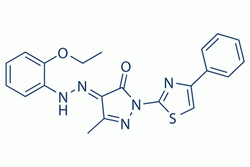| Cas No.: | 331244-89-4 |
| Chemical Name: | 1H-Pyrazole-4,5-dione,3-methyl-1-(4-phenyl-2-thiazolyl)-,4-[2-(2-ethoxyphenyl)hydrazone] |
| Synonyms: | BAM7; BAM-7 |
| SMILES: | CCOC1=CC=CC=C1N/N=C2C(C)=NN(C3=NC(C4=CC=CC=C4)=CS3)C2=O |
| Formula: | C21H19N5O2S |
| M.Wt: | 405.47 |
| Description: | BAM7 is a direct and selective activator of proapoptotic BAX with an IC50 of 3.3 μM. |
| Target: | Bax:3.3 μM (IC50) |
| In Vivo: | MEF cells are maintained in DMEM high glucose supplemented with 10% (v/v) FBS, 100 U/mL Penicillin, 100 μg/mL Streptomycin, 2 mM L-glutamine, 50 mM HEPES, 0.1 mM MEM nonessential amino acids and 50 μM β-mercaptoethanol. MEFs (2.5×103 cells per well) are seeded in 96-well opaque plates for 18-24 h and then incubated with serial dilutions of BAM7 (3.75, 5, 7.5, 10 and 15 μM), ANA-BAM16 or vehicle (0.15% (v/v) DMSO) in DMEM at 37°C in a final volume of 100 μL. Cell viability is assayed at 24 h by addition of CellTiter-Glo reagent, and luminescence is measured using a SpectraMax M5 microplate reader. Viability assays are performed in at least triplicate, and the data are normalized to vehicle-treated control wells[1]. |
| In Vitro: | BAM7 is selective for the BH3-binding site on BAX. BAM7 activates BAX and BAX-dependent cell death. Whereas treatment with BAX or BAM7 alone has no effect on the liposomes, the combination of BAM7 and BAX yields dose-responsive liposomal release of entrapped fluorophore. BAM7 dose- and time-responsively impairs the viability of Bak-/- MEFs that exclusively express BAX but has no effect on Bak-/- MEFs that contain BAK but lack BAX. In contrast, standard proapoptotic stimuli such as serum withdrawal, Staurosporine and Etoposide induces an equivalent apoptotic response in Bax-/- and Bak-/- MEFs. As further evidence of BAM7 specificity of action, (i) BAM7 does not affect the viability of Bax-/- Bak-/- MEFs; (ii) ANA-BAM16, which does not bind or activate BAX, has no effect on Bak-/- MEFs; and (iii) BAM7 selectively induces cell death of Bax-/- Bak-/- MEFs reconstituted with wild-type BAX but not BAXK21E , which bears the mutation that abrogates BAM7 binding[1]. |
| References: | [1]. Gavathiotis E, et al. Direct and selective small-molecule activation of proapoptotic BAX. Nat Chem Biol. 2012 Jul;8(7):639-45. |

 To enhance service speed and avoid tariff delays, we've opened a US warehouse. All US orders ship directly from our US facility.
To enhance service speed and avoid tariff delays, we've opened a US warehouse. All US orders ship directly from our US facility.




















